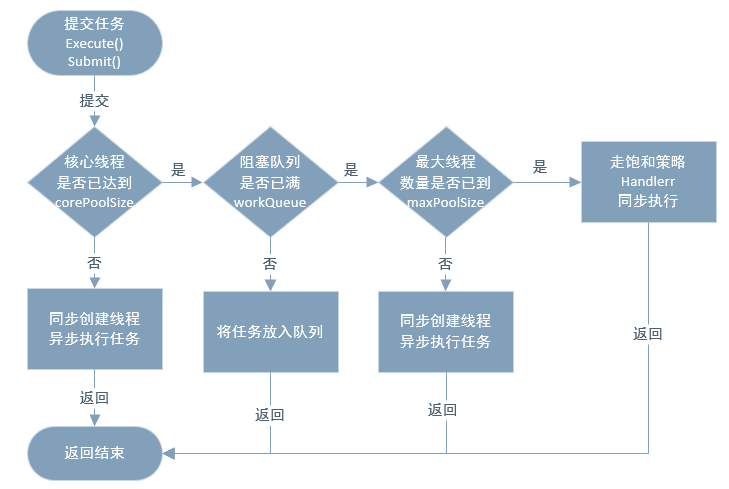线程池工厂Executors编程的艺术
Executors是一个线程池的工厂类,提供各种有用的线程池的创建,使用得当,将会使我们并发编程变得简单!今天就来聊聊这个工厂类的艺术吧!
Executors只是Executor框架的主要成员组件之一,为java的异步任务调度执行提供了重要的入口!
在说Executors之前,还需要说一下另一个Executor框架的重要成员,ThreadPoolExecutor。
ThreadPoolExecutor 实现了ExecutorService接口,提供了线程池的调度功能!成为纯种池技术的基石!
ThreadPoolExecutor 的主要构造函数:
/**
* Creates a new {@code ThreadPoolExecutor} with the given initial
* parameters.
*
* @param corePoolSize the number of threads to keep in the pool, even
* if they are idle, unless {@code allowCoreThreadTimeOut} is set
* @param maximumPoolSize the maximum number of threads to allow in the
* pool
* @param keepAliveTime when the number of threads is greater than
* the core, this is the maximum time that excess idle threads
* will wait for new tasks before terminating.
* @param unit the time unit for the {@code keepAliveTime} argument
* @param workQueue the queue to use for holding tasks before they are
* executed. This queue will hold only the {@code Runnable}
* tasks submitted by the {@code execute} method.
* @param threadFactory the factory to use when the executor
* creates a new thread
* @param handler the handler to use when execution is blocked
* because the thread bounds and queue capacities are reached
* @throws IllegalArgumentException if one of the following holds:<br>
* {@code corePoolSize < 0}<br>
* {@code keepAliveTime < 0}<br>
* {@code maximumPoolSize <= 0}<br>
* {@code maximumPoolSize < corePoolSize}
* @throws NullPointerException if {@code workQueue}
* or {@code threadFactory} or {@code handler} is null
*/
public ThreadPoolExecutor(int corePoolSize,
int maximumPoolSize,
long keepAliveTime,
TimeUnit unit,
BlockingQueue<Runnable> workQueue,
ThreadFactory threadFactory,
RejectedExecutionHandler handler) {
if (corePoolSize < 0 ||
maximumPoolSize <= 0 ||
maximumPoolSize < corePoolSize ||
keepAliveTime < 0)
throw new IllegalArgumentException();
if (workQueue == null || threadFactory == null || handler == null)
throw new NullPointerException();
this.corePoolSize = corePoolSize;
this.maximumPoolSize = maximumPoolSize;
this.workQueue = workQueue;
this.keepAliveTime = unit.toNanos(keepAliveTime);
this.threadFactory = threadFactory;
this.handler = handler;
}
咱们此处不是要去分析其源码,只是想看一下怎样使用他!
从构造方法可以看出 ThreadPoolExecutor 的主要参数 7 个,在其注释上也有说明功能,咱们翻译下每个参数的功能:
corePoolSize: 线程池核心线程数(平时保留的线程数),使用时机: 在初始时刻,每次请求进来都会创建一个线程直到达到该size
maximumPoolSize: 线程池最大线程数,使用时机: 当workQueue都放不下时,启动新线程,直到最大线程数,此时到达线程池的极限
keepAliveTime/unit: 超出corePoolSize数量的线程的保留时间,unit为时间单位
workQueue: 阻塞队列,当核心线程数达到或者超出后,会先尝试将任务放入该队列由各线程自行消费;
ArrayBlockingQueue: 构造函数一定要传大小
LinkedBlockingQueue: 构造函数不传大小会默认为65536(Integer.MAX_VALUE ),当大量请求任务时,容易造成 内存耗尽。
SynchronousQueue: 同步队列,一个没有存储空间的阻塞队列 ,将任务同步交付给工作线程。
PriorityBlockingQueue: 优先队列
threadFactory:线程工厂,用于线程需要创建时,调用其newThread()生产新线程使用
handler: 饱和策略,当队列已放不下任务,且创建的线程已达到 maximum 后,则不能再处理任务,直接将任务交给饱和策略
AbortPolicy: 直接抛弃(默认)
CallerRunsPolicy: 用调用者的线程执行任务
DiscardOldestPolicy: 抛弃队列中最久的任务
DiscardPolicy: 抛弃当前任务
所以,虽然参数有点多,但是其实仔细阅读以上的注释,基本就能很好地使用线程池了,不过咱们还可以通过一个流程图来说明这一切,对于喜欢看图说话的同学来说是件好事!

好了,ThreadPoolExecutor 介绍完后,什么感觉呢? 说是简单,其实还是挺麻烦的,毕竟你还要去了解各种队列的公优缺点,去了解线程池范围怎样设置合理。所以,是时候让 Executors 工厂出场了!
作为一个工厂类,Executors 简化了各种参数,只忘文生义即可明白其意思!Executors 主要提供4种类型的线程池!
1. FixedThreadPool 创建一个指定数量的线程池
可控制线程最大并发数,超出的线程会在队列中等待。
其实现方式如下:
public static ExecutorService newFixedThreadPool(int nThreads) {
return new ThreadPoolExecutor(nThreads, nThreads,
0L, TimeUnit.MILLISECONDS,
new LinkedBlockingQueue<Runnable>());
}
使用固定线程数的worker和无界队列保存多余的task,所以创建的线程数不会超过corePoolSize,所以maxPoolSize是一个无效参数,所以keepAliveTime是一个无效参数,所以不会调用RejectedExecutionHandler.rejectedExecution()方法,即无拒绝策略可用;从而在外部表现来看,就是固定线程,在执行无限的队列!
2. SingleThreadExecutor 创建一个单线程化的线程池
它只会用唯一的工作线程来执行任务,保证所有任务按照指定顺序(FIFO, LIFO, 优先级)执行。
其实现方式如下:
public static ExecutorService newSingleThreadExecutor() {
return new FinalizableDelegatedExecutorService
(new ThreadPoolExecutor(1, 1,
0L, TimeUnit.MILLISECONDS,
new LinkedBlockingQueue<Runnable>()));
}
与 FixedThreadPool 原理类似,不过这里只会使用一个线程在运行。使用一个线程可以保证取任务时的顺序一致性,从而表现出先到先得的效果!在要求有执行顺序要求的场景,刚好派上用场!
3. CachedThreadPool, 创建一个可缓存的无限线程池
如果线程池长度超过处理需要,可灵活回收空闲线程,若无可回收,则新建线程。
其实现方式如下:
public static ExecutorService newCachedThreadPool() {
return new ThreadPoolExecutor(0, Integer.MAX_VALUE,
60L, TimeUnit.SECONDS,
new SynchronousQueue<Runnable>());
}
使用SyncronousQueue作为线程池的工作队列,这是特殊的队列,它是个没容量的阻塞队列(至于为什么要用这个特性,据说是性能比 LinkedBlockingQueue 更高,详解他),每个插入操作必须有一个线程对应的移除操作,反之一样;当提交一个cached任务时,执行SyncronousQueue.offer(x),如果有等待的空闲线程,则匹配成功,exec立即返回;如果没有匹配,则会创建一个新线程执行任务;任务执行完后使用poll()等待keep即60秒,一直尝试从队列中获取任务,超时后自动释放线程;
使用这种线程池把握好节奏,因为看起来线程池动不动就会创建系列线程池,而且动不动就会释放线程,完全是不可控的,不可监控的。
4. ScheduledThreadPool 创建一个定长线程池
支持定时及周期性任务执行。
其实现如下:
public static ScheduledExecutorService newScheduledThreadPool(int corePoolSize) {
return new ScheduledThreadPoolExecutor(corePoolSize);
}
看起来,这个在参数方面没有太多的解说,只是依赖于 ScheduledThreadPoolExecutor 的实现了!所以,我们来看一下 ScheduledThreadPoolExecutor是怎么实现的?
public class ScheduledThreadPoolExecutor extends ThreadPoolExecutor {}
public ScheduledThreadPoolExecutor(int corePoolSize) {
super(corePoolSize, Integer.MAX_VALUE, 0, NANOSECONDS,
new DelayedWorkQueue());
}
ok, 如上两个,就够了!ScheduledThreadPoolExecutor 也是继承了 ThreadPoolExecutor, 其构造方法也是依赖于父类,只是将 队列实现改为 DelayedWorkQueue,从而实现延时运行或者定期执行的效果!
而相比于 Timer 来说,ScheduledThreadPool会有更好的执行效果,因为Timer只会有一个线程来执行任务,会有局限性。而且 ScheduledThreadPool 提供其他很多的可操作方法!
Executors 的出现,使线程池的使用难度大大降低,使开发更方便,在合适的场合使用相应的工厂方法,定能让开发事半功倍!
线程池工厂Executors编程的艺术的更多相关文章
- java笔记--使用线程池优化多线程编程
使用线程池优化多线程编程 认识线程池 在Java中,所有的对象都是需要通过new操作符来创建的,如果创建大量短生命周期的对象,将会使得整个程序的性能非常的低下.这种时候就需要用到了池的技术,比如数据库 ...
- 线程池之 Executors
线程池之 Executors + 面试题 线程池的创建分为两种方式:ThreadPoolExecutor 和 Executors,上一节学习了 ThreadPoolExecutor 的使用方式,本节重 ...
- 线程池——JAVA并发编程指南
TPS00-J. 用线程池实现应用在流量暴涨时优雅降级 很多程序都要解决这样一个问题——处理一系列外来的请求.Thread- Per-Message这种设计模式是最简单的并发策略了,它为每一个请求创建 ...
- Java线程池ThreadPoolExecutor&&Executors
一.先看看传统的开启线程. new Thread(new Runnable() { @Override public void run() { } }).start(); 缺点: 1.每次new Th ...
- Java并发包线程池之Executors、ExecutorCompletionService工具类
前言 前面介绍了Java并发包提供的三种线程池,它们用处各不相同,接下来介绍一些工具类,对这三种线程池的使用. Executors Executors是JDK1.5就开始存在是一个线程池工具类,它定义 ...
- 线程池工厂方法newFixedThreadPool()和newCachedThreadPool()
newFixedThreadPool()方法: 该方法返回一个固定数量的线程池,当一个新的任务提交时,线程池中若有空闲线程,则立即执行. 若没有.则新的任务被暂存在一个任务队列中,待线程空闲时,便处理 ...
- ThreadFactory 线程池工厂
import java.util.concurrent.ExecutorService; import java.util.concurrent.Executors; public class Thr ...
- 线程池(2)-Executors提供4个线程池
1.为什么不使用Executors提供4个线程池创建线程池 阿里巴巴开放手册这样写: . [强制]线程池不允许使用 Executors 去创建,而是通过 ThreadPoolExecutor 的方式, ...
- 线程池工厂方法newScheduledThreadPool(),计划任务
package com.thread.test.ThreadPool; import java.util.concurrent.Executors; import java.util.concurre ...
随机推荐
- 谈谈逆向android里面的so
1. 加密sgf算法分析 2.gnugo瘦身记
- skynet记录7:第一个服务logger和第二个服务bootstrap
(1)logger是skynet_context_new创建:skynet_context及mq,模块create和init (2)bootstrap启动过程:snlua时一个lua的so,对应的sn ...
- Ax用Excel导出表的字段属性信息
static void CKT_ExportTableColnum(Args _args){ LJD_QaHalf_Figure _LJD_QaHalf_Figure; SysDictTable sd ...
- Windows PowerShell基本语法及常用命令
PowerShell常用命令: 一 Get类 1.Get-Command : 得到所有PowerShell命令,获取有关 cmdlet 以及有关 Windows PowerShell 命令的其他元素的 ...
- HTML 中使用 JavaScript
在 HTML 中插入 JavaScript 的主要方法,就是使用 <script> 元素, 浏览器会解释并执行其中的 JavaScript 代码. <script> 元素的属 ...
- AX_Query
static void example(Args _args) { SysQueryRun queryRun = new SysQueryRun(querystr(KTL_Sale ...
- 464. Can I Win
https://leetcode.com/problems/can-i-win/description/ In the "100 game," two players take t ...
- 通过GPLOT过程制作图形
通过GPLOT过程制作图形 和数据报表一样,图形也是展现数据的重要方法,图形的直观效果是数据报表无法替代的.SAS/GRAPH是SAS进行数据可视化展现的重 要组成部分,具有强大的作图功能.可以展现的 ...
- Effective Java 【考虑实现Comparable接口】
Effective Java --Comparable接口 compareTo方法是Comparable接口的唯一方法.类实现了Comparable接口,表明它的实例具有内在的排序关系. 自己实现co ...
- JavaScript中的Undefined / Null 类型相关说明
1,综述: ※Undefined 和 Null是JavaScript中的两种数据类型(其他的类型还有:Boolean, String, Number, Object). ※Undefined类型只有一 ...
